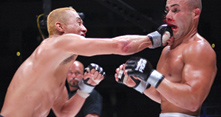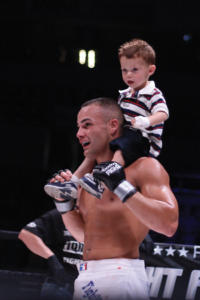
Eddie Alvarez loves to beat the shit out of people—he’s been doing it most of his life. Much like Philly’s beloved Rocky Balboa, the 25-year- old relied heavily on his strong fighting spirit and quick hands to overcome a lack of size—at 5-foot-8-inches tall, he’s built like a Ninja Turtle—while defending his honor and life during the numerous street fights he encountered growing up in Kensington.
“I’m not that big a person so people aren’t that afraid of me. So people would mess with someone like me,” he says.
By the time Alvarez was 18, he was rumbling on a regular basis. In those days, street fights were a popular pastime in Philadelphia’s roughest areas—Alvarez shrugs it off as something that guys just “liked to do”—and brawls spontaneously erupted throughout the city. Armed with a weekly paycheck and his brother’s ID, Alvarez spent much of his free time hanging out in bars with friends who didn’t believe in peaceful conflict resolution. As a result, he fought almost every weekend for the next two years—and he was winning.
Six years later, Alvarez still battles every weekend, but the forum has moved from the streets of Philly to metal Octagon cages all over the world.
Alvarez, aka Silent Assassin, is now the No. 2 ranked lightweight in the burgeoning world of Mixed Martial Arts (MMA).
Training out of the Philadelphia Fight Factory—with an impressive record of 16-2—the prizefighter is a long way from his scrappy, street-fighting days in the hood: He no longer spends his Friday nights pummeling his way through impromptu melees, with nothing but the will to win. These days he prepares for fights diligently and professionally, and spends his weekends taking on highly skilled opponents for ESPN Bellator’s new lightweight tournament.
Alvarez has become a well-rounded fighter—both an excellent wrestler and a dangerous striker. He has a flair for the knockout, and often begins his fight with finesse: moving lightly on his feet and picking his shots. But he’s still willing to brawl, and has developed a style that resembles a one-man blitzkrieg; a rapid concentrated attack.
His accomplishments come at a time when extreme fighting is finally gaining mainstream respect. After decades of being touted as a barbaric sport, Mixed Martial Arts has enjoyed a surge of popularity over the last five years. Once known as the inhumane spectacle that John McCain referred to as human cockfighting, extreme fighting has gone from barbarous game to legitimate combat sport on the same plane as boxing.
The stigma is eroding and endorsement money is flowing. Naturally, when money’s at issue, all things illegal and hated quickly become legal and beloved. Subscriber fees for Ultimate Fighting Championship pay-per-view events raked in more than $220 million in 2006.
Following suit, the mainstream media has descended on the sport and its new breed of lucrative gladiator. Various mixed martial artists can be found mugging on the covers of magazines and on TV.
While this sort of exposure has been limited to fighters signed to the sport’s largest promoter, Ultimate Fighting Championship (UFC), cutting-edge fighters of relatively unknown camps, like Alvarez, are also reaping the benefits of this money-making industry.
Locally, the sport is taking off as well. In February, Pennsylvania became one of 39 states to legalize extreme fighting and allow professional Mixed Martial Arts contests to be sanctioned. The state will host up to five MMA events per month, and anticipates generating roughly $80,000 per year in revenue for the athletic commission.

Alvarez is not your typical participant in the MMA. Studying martial arts disciplines can be expensive, and students typically come from middle class families. Many of the fighters have college degrees, like UFC lightweight champion BJ Penn, who comes from a prominent real estate family in Hawaii. Another lightweight, Kenny Florian, has a degree in communications from Boston College.
Nevertheless, Alvarez, a blue-collar guy whose formal training began in a basement, is building a viable career on the strength of some incredible performances and a survival-of-the-fittest mentality.
“I came from a pretty shitty neighborhood,” he says. “A pretty rough neighborhood. I fought. I never had much. So I wouldn’t be your typical MMA fighter who came from a well-off family and just decided to do whatever.”
Fighting influences were also exerted in Alvarez’s Puerto Rican household. His grandfather was a boxer who made it to the Pan American games, and his father, Louis Alvarez, also had lessons to impart on the sweet science. He made sure his son knew how to defend himself, and how to throw a proper punch. He supplied him with boxing gloves, a punching bag and equipment to work out with.
“I always found myself having fun when we did stuff like that at my house,” says Alvarez. “My dad was a huge inspiration to me as far as fighting.”
Bill Hunter was Alvarez’s first wrestling coach and a police officer working the 25th District at the time. He kept an eye on Alvarez when he was in the neighborhood. Hunter describes Alvarez as “a perfect gentleman” who largely kept himself out of trouble, a kid who was street-smart and street-tough, but also very intelligent. Hunter says that Alvarez never shied away from confrontation, and he excelled at sports, participating in everything from track to baseball, football and wrestling.
Alvarez entered the martial arts scene in the late ’90s through a basement door. During his senior year of high school he met Stephen Haigh, an art student at community college who was competing in MMA on the side. At the time, Haigh was training at the Philadelphia Sambo (a Russian hybrid martial art) Academy. When the gym closed, Haigh bought the mats for cheap, and set up a training facility in his uncle’s basement.
He had 12 guys preparing for fights out of the small space when Alvarez showed up. Haigh admits that back then it felt more like an underground fight club than a legitimate school.
Alvarez, a pure wrestler at the time, mucked around a bit and liked it, but shortly after he graduated from high school he had to find a job. He fell into the rhythm of a normal work life, and Haigh didn’t hear from him for months.
But Alvarez’s love of fighting and his natural skill created the itch to compete, so he got back in touch with Haigh, who’d begun teaching classes at Body Arts. With only eight months of formal training, Alvarez made his pro debut in Atlantic City with the Ring of Combat promotion. He would go on to carry his self-professed undefeated record in unsanctioned fights over into sanctioned fighting.
It seems fast, but in those days MMA was only beginning to evolve as a legitimate sport, and the boxing commissions were just beginning to get involved. There was no pro/amateur divide because there was no amateur circuit.
“You just went pro,” says Alvarez. “There was no other option if you weren’t pro.”
In his first fight, Alvarez knocked his opponent out cold in the first round. That’s when it hit him: “You know what? I’m pretty good at this, and I could probably make some money doing it.”
The neighborhood brawler quickly amassed a perfect 10-0 record.
Alvarez didn’t have a hard time booking fights. He was a promoter’s dream, an electric fighter who brought a crowd by virtue of his regional ties.
“A big part of that was the fans, and my friends, the support from Philly coming to my fights. I not only did well performing for promoters, but they knew I brought a lot of people. In promoters’ eyes, that means money,” he says.
These days when he fights in the area, he brings anywhere from 700 to 1,000 rowdy Philadelphians behind him. His fans sport Eddie Alvarez T-shirts and root for their hometown kid.
After three years in the game Alvarez was offered a contract with the Bodog Fight promotion.
It was kind of just a hobby,” says Alvarez. “It turned into something I loved and a career.”
After that he was signed with the promotion ProElite for a while. The company had a broadcasting deal with CBS and Showtime, and Alvarez was scheduled to fight crowdpleaser Nick Diaz on Nov. 8 when the company suddenly filed for bankruptcy and folded. Bellator Fighting Championship, the new MMA fight promotion—which began airing lightweight tournaments on ESPN Deportes last week—immediately swooped up Alvarez.

Alvarez does a celebratory back flip off the top of the Octagon cage in which he just fought Britain’s Greg Loughran. The Mixed Martial Arts emissary emerged victorious during the first round of the Bellator competition, which took place last Friday night in Hollywood, Fla.
The win didn’t come easy. Early on in the fight it looked as if Alvarez was about to succumb to his ghostly British opponent. At one point, Alvarez, ever the aggressor, was intercepted on his way inside by a solid Loughran counter punch. The crowd let out a collective gasp when Alvarez fell to one knee and appeared dazed. For a moment, his fans back home in North Philly were scared—phone calls from the 215 flooded Alvarez’s phone.
But he came back from the verge of sleep and went for a double leg and eventually slammed Loughran to the mat. Alvarez then slithered an arm around his opponent’s neck and tightened a guillotine choke. The fight was over. The hometown hero stole the victory.
It’s an impressive win considering it was Alvarez’s first fight since suffering an injury caused in a loss on New Year’s Eve to wiry Japanese grappler Shinya Aoki. It was only his second career loss, but it was costly. Aoki managed to trap Alvarez’s leg and crank his knee joint like a twist-off bottle cap. Alvarez felt his knee crunch a few times before tapping out. His time off for rehab and training did wonders.
In preparation for a fight Alvarez trains nearly seven days a week: conditioning, grappling, muay thai and game planning. His diet becomes a Spartan menu he doesn’t particularly enjoy so that he can make weight. He is nearly vegetarian. Meat can take too much energy to digest, he says—energy he needs to train.
On a Thursday night in Fishtown, Alvarez is at the Fight Factory putting in work with a contingent of about eight other fighters in the small gym. The brick walls are painted white, and the place is spare save for the necessary equipment.
“In bigger camps there are a lot of jealous egos,” says Alvarez. “All we care about is getting better.”
Tonight they drill takedowns and ground work. Whether Alvarez is practicing a takedown or doing live grappling, it’s apparent the man can generate an improbable amount of force for his size. Alvarez’s eyes go cold as he demonstrates several variations on a series of strikes coming after a change in stance. Then he nods and says, “It’s all off that one switch. Good shit.”
Outside of the ring, Alvarez comes off entirely too affable to be the bruiser who finishes 70 percent of his fights by KO or TKO. He’s a happily married man with two kids and supportive parents who still live in Kensington. He works hard to maintain a balance between family, a close group of friends and a demanding work schedule. A normal guy.
If you ask Alvarez, he’d probably tell you that he has everything that he ever wanted. But many wonder why such a talented fighter isn’t signed with the UFC. It seems a good fit. He’s electrifying in the ring and charismatic outside of it, so Alvarez could be a major draw there. The UFC practically constitutes a monopoly.
Unlike boxing where there are many big promotions for fighters to sign with, in MMA there is the UFC and then a field of upstarts and smaller organizations. Alvarez’s decision to stay in the lesser-known camp puzzles fans throughout the Mixed Martial Arts blogosphere who question why Alvarez hasn’t moved on to the big stage.
His new boss agrees with the fame and fortune part, but there’s no way he’s going to let Alvarez go to a different camp.
“The one thing about Eddie Alvarez is: He has not yet received the nationwide television exposure here in the U.S. that is an absolute, absolute necessary element to creating a superstar,” says Bjorn Rebney, CEO of Bellator Fighting Championship, the new MMA fight promotion that signed Alvarez last November.
From a promotional standpoint, Rebney thinks Alvarez has the story, the looks, the charisma and the skills to cross over into the mainstream.
“I mean, when you’re looking for someone you can promote, I hearken back to the early days when I was with De La Hoya,” says Rebney, who represented the famed boxer from 1993 to 1997.
The problem for Alvarez is that the UFC is notorious for offering fighters one-sided contracts.
“The UFC wants a lot of things for a little bit of money,” he says. He likens the division more to the NFL without a players union, a league minimum or any kind of arbitration than to a traditional fight promotion. This is part of the new fight game as well.
For the meantime, Alvarez is happy with his partnership with the ESPN Bellator promotion. It’s a busy schedule: three fight cards in 12 weeks. According to bellator.com, to win the Bellator Championship, a fighter must win all three fights, each one comprised of three five-minute rounds. At the end of a three-month season, Bellator will have crowned four champions and will have awarded each $175,000.
For all of its newfound glamour, Mixed Martial Arts is still a violent and precarious endeavor, one where you don’t get health insurance although injuries are a certainty, and you don’t get a pension though careers are short.
There are only so many lucrative paydays out there, and you’re guaranteed to get the hell beat out of you chasing them. When you do catch one, even the biggest MMA payouts are meager in comparison to those of boxing. Boxer Manny Pacquiao made $15 to $30 million in pay-per-view shares plus an additional guaranteed amount for his fight with Oscar De La Hoya. If you are a marquee lightweight in MMA, the take-home is closer to $170,000.
Still, that’s a lot of money for a neighborhood guy like Alvarez who sees the money as a way to get his family away from the tough neighborhood that he grew up in. After his loss in January, Alvarez moved his wife and children to a new house in Morrell Park.
And with Alvarez’s Hispanic following, he may be able to bring the fame and fortune of the UFC to the rest of the MMA scene.
“Mixed Martial Arts is becoming increasingly popular among Hispanics and we are thrilled to work with Bellator Fighting Championships to showcase these world-class athletes on a national platform,” said Lino Garcia, general manager of ESPN Deportes in an Aftermarket News story. “The structure of this championship will give fans a unique opportunity to follow their athletes as the tournament progresses.”
If Bellator does well, Alvarez’s fight will be televised in the English- language market as well as pay-per-view events.
Back at the Fight Factory, Haigh teases Alvarez that because of his recklessness he’ll soon have to retire his signature victory back flip off the ring in favor of being rolled out in a wheelchair.
When that happens, Alvarez says, he’ll being doing wheelies all the way.




